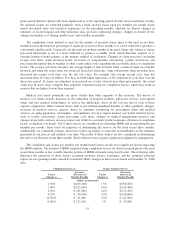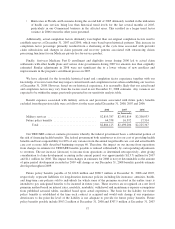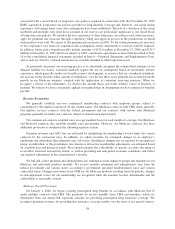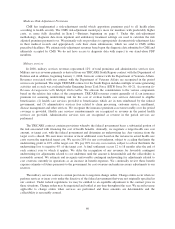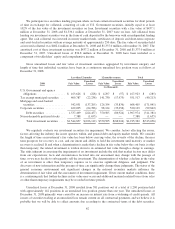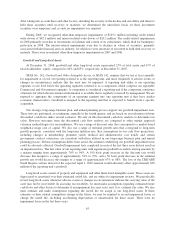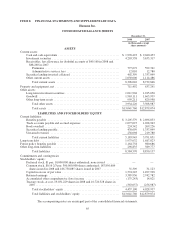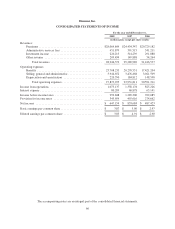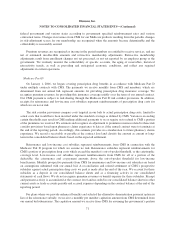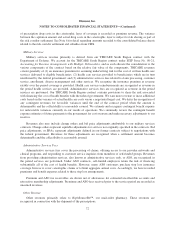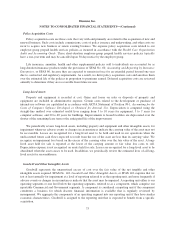Humana 2008 Annual Report Download - page 73
Download and view the complete annual report
Please find page 73 of the 2008 Humana annual report below. You can navigate through the pages in the report by either clicking on the pages listed below, or by using the keyword search tool below to find specific information within the annual report.After taking into account these and other factors, including the severity of the decline and our ability and intent to
hold these securities until recovery or maturity, we determined the unrealized losses on these investment
securities were temporary and, as such, no impairment was required.
During 2008, we recognized other-than-temporary impairments of $103.1 million including credit related
write-downs of $82.9 million and interest-related write-downs of $20.2 million. The credit-related impairments
in 2008 primarily were due to investments in Lehman and certain of its subsidiaries, which filed for bankruptcy
protection in 2008. The interest-related impairments were due to declines in values of securities, primarily
associated with the financial services industry, for which we were uncertain of our intent to hold until recovery or
maturity. There were no material other-than-temporary impairments in 2007 and 2006.
Goodwill and Long-lived Assets
At December 31, 2008, goodwill and other long-lived assets represented 23% of total assets and 67% of
total stockholders’ equity, compared to 20% and 63%, respectively, at December 31, 2007.
SFAS No. 142, Goodwill and Other Intangible Assets, or SFAS 142, requires that we test at least annually
for impairment at a level of reporting referred to as the reporting unit, and more frequently if adverse events or
changes in circumstances indicate that the asset may be impaired. A reporting unit either is our operating
segments or one level below the operating segments, referred to as a component, which comprise our reportable
Commercial and Government segments. A component is considered a reporting unit if the component constitutes
a business for which discrete financial information is available that is regularly reviewed by management. We are
required to aggregate the components of an operating segment into one reporting unit if they have similar
economic characteristics. Goodwill is assigned to the reporting unit that is expected to benefit from a specific
acquisition.
Our strategy, long-range business plan, and annual planning process support our goodwill impairment tests.
These tests are performed, at a minimum, annually in the fourth quarter, and are based on an evaluation of future
discounted cash flows under several scenarios. We rely on this discounted cash flow analysis to determine fair
value. However outcomes from the discounted cash flow analysis are compared to other market approach
valuation methodologies for reasonableness. We use a range of discount rates that correspond to a market-based
weighted-average cost of capital. We also use a range of terminal growth rates that correspond to long-term
growth prospects, consistent with the long-term inflation rate. Key assumptions in our cash flow projections,
including changes in membership, premium yields, medical and administrative cost trends, and certain
government contract extensions, are consistent with those utilized in our long-range business plan and annual
planning process. If these assumptions differ from actual, the estimates underlying our goodwill impairment tests
could be adversely affected. Goodwill impairment tests completed in each of the last three years did not result in
an impairment loss. The fair value of our reporting units with significant goodwill exceeded carrying amounts by
a margin ranging from approximately 76% to 94%. A 100 basis point increase in the discount rate would
decrease this margin to a range of approximately 54% to 79%, and a 50 basis point decrease in the terminal
growth rate would decrease this margin to a range of approximately 67% to 88%. The loss of the TRICARE
South Region contract instead of the expected April 1, 2010 renewal would adversely affect approximately $50
million of the reporting unit’s goodwill.
Long-lived assets consist of property and equipment and other finite-lived intangible assets. These assets are
depreciated or amortized over their estimated useful life, and are subject to impairment reviews. We periodically
review long-lived assets whenever adverse events or changes in circumstances indicate the carrying value of the
asset may not be recoverable. In assessing recoverability, we must make assumptions regarding estimated future
cash flows and other factors to determine if an impairment loss may exist, and, if so, estimate fair value. We also
must estimate and make assumptions regarding the useful life we assign to our long-lived assets. If these
estimates or their related assumptions change in the future, we may be required to record impairment losses or
change the useful life, including accelerating depreciation or amortization for these assets. There were no
impairment losses in the last three years.
63




